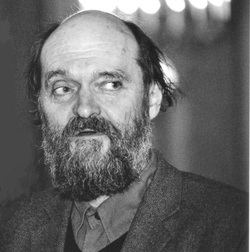
He was born in Estonia in 1935, and his early works showed the influence of Shostakovich, Prokofiev and Schoenberg. Then, in 1968, he stopped composing for several years, devoting himself to the study of music of the distant past. And then, inspired by Gregorian chant and Renaissance polyphony, he forged a new style, which he called “tintinnambuli.” Because of the overt historicism of this music, it’s sometimes hard to know if a work by Pärt was written last week or a thousand years ago.
Pärt’s Summa of 1978 was originally a vocal setting of the Credo text of the Latin mass. After the work’s premiere, the composer re-scored it for string quartet, and then for string orchestra. (There’s also an arrangement for saxophone quartet.)
I like the solemn simplicity of Summa. It stands firmly in one place, resolutely being what it is, yet with a fluid elegance – and with indifference to the transient fashions of modernity. This music manages to be structurally solid and mysteriously intangible at the same time.
Here it is, in a lush performance by the Bournemouth Sinfonietta, under Richard Studt.
© Colin Eatock 2012
 RSS Feed
RSS Feed

